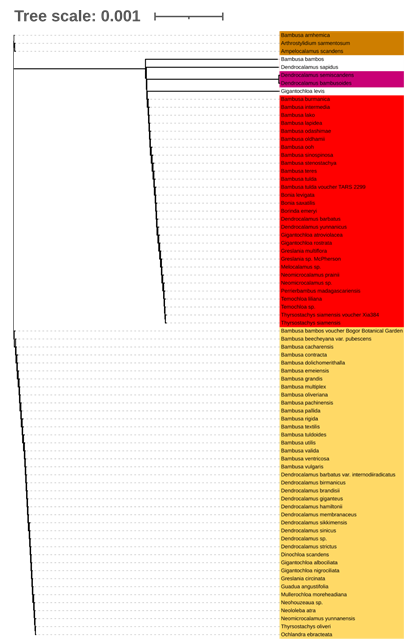A comparative study of DNA barcoding markers for Bamboo
DOI:
https://doi.org/10.70158/buitenzorg.v1i2.9Abstract
The Bambusoideae subfamily, a significant group within the Poaceae family, contains diverse genera with complex taxonomic relationships. This study aimed to elucidate the phylogenetic relationships and genetic diversity within the bamboo, focusing on the utility of DNA barcoding markers, i.e., ITS2, matK, and rbcL, in bamboo species identification. By analyzing sequence data from these markers, phylogenetic trees were constructed using the maximum likelihood method to infer evolutionary relationships among species. The results showed that ITS provides the highest resolution for species-level identification, distinguishing closely related species more effectively than matK and rbcL. While matK demonstrated robust genus-level classification, rbcL was limited by its high conservation, making it more suitable for broader taxonomic groupings. These findings contribute to a better understanding of bamboo taxonomy and highlight the importance of marker selection based on the taxonomic resolution required. The study also emphasizes the complementary use of these markers to provide a comprehensive view of bamboo phylogenetics.
Keywords: bamboo taxonomy, DNA barcoding, ITS2, matK, rbcL
Downloads
References
Benton, A. (2015). Priority Species of Bamboo. In: Liese, W., Köhl, M. (eds) Bamboo. Tropical Forestry, vol 10. Springer, Cham. https://doi.org/10.1007/978-3-319-14133-6_2
Bhat, A. R., Hegde, S., Kammar, S. R., Muthamma, M. B., Mudgal, G., Mohan, T. C., Rajulu, C. (2024). Identification and validation of ITS2-specific universal primers for DNA barcoding in plants. bioRxiv, 2024-01 https://doi.org/10.1101/2024.01.05.574284
Cetiz, M.V., Turumtay, E.A., Burnaz, N.A. et al. (2023). Phylogenetic analysis based on the ITS, matK and rbcL DNA barcodes and comparison of chemical contents of twelve Paeonia taxa in Türkiye. Mol Biol Rep 50, 5195–5208. https://doi.org/10.1007/s11033-023-08435-z
Clark, L.G., Dransfield, S., Triplett, J. and Sánchez-Ken, J.G. (2007). Phylogenetic relationships amongthe one-flowered, determinate genera of Bambuseae (Poaceae: Bambusoideae). Aliso: A Journal of Systematic and Floristic Botany, 23(1), 315–332. https://doi.org/10.5642/aliso.20072301.26
Friar, E., & Kochert, G. (1994). A study of genetic variation and evolution of Phyllostachys (Bambusoideae: Poaceae) using nuclear restriction fragment length polymorphisms. Theoret. Appl. Genetics 89, 265–270. https://doi.org/10.1007/BF00225152
Gogoi, B., Bhau, B.S. (2018). DNA barcoding of the genus Nepenthes (Pitcher plant): a preliminary assessment towards its identification. BMC Plant Biol 18, 153. https://doi.org/10.1186/s12870-018-1375-5
Hodkinson, T., Renvoize, S., Chonghaile, G. et al. (2000). A Comparison of ITS Nuclear rDNA Sequence Data and AFLP Markers for Phylogenetic Studies in Phyllostachys (Bambusoideae, Poaceae). J Plant Res 113, 259–269. https://doi.org/10.1007/PL00013936
Jeevitha, S., & Anandan, R. (2024). Identification and classification of medicinal plant Cassia species through DNA barcode to validate phylogenic analysis of Rbcl, Matk, Ycflb, trnH-psba and ITS marker. Ecology, Environment and Conservation, 30(02), 957–964. https://doi.org/10.53550/eec.2024.v30i02.089
Letsiou, S., Madesis, P., Vasdekis, E. P., Montemurro, C., Grigoriou, M. E., Skavdis, G., Moussis, V., Koutelidakis, A. E., Tzakos, A. G. (2024). DNA Barcoding as a Plant Identification Method. Applied Sciences, 14(4), 1415. https://doi.org/10.3390/app14041415
Lonthor, D. W., Miftahudin, Kayat, Julzarika, A., Subehi, L., Iswandono, E., Dima, A. O. M., Dianto, A., Setiawan, F., & Nugraha, M. F. I. (2023). Diversity of aquatic plants in the Rote Dead Sea area, East Nusa Tenggara, Indonesia, based on rbcL marker. Biodiversitas, 24(2), 810–818. https://doi.org/10.13057/biodiv/d240217
Omonhinmin, C. A., Olomukoro, E. E., Onuselogu, C. C., Popoola, J. O., Oyejide, S. O. rbcL gene dataset on intra-specific genetic variability and phylogenetic relationship of Crassocephalum crepidioides (Benth) S. Moore. (Asteraceae) in Nigeria. Data Brief. 2023 May 26;48: 109266. https://doi.org/10.1016/j.dib.2023.109266
Susanti, F., Adharini, R. I., Sari, D. W. K., & Setyobudi, E. (2023). Genetic Diversity of Gracilaria spp. in the Intertidal Zone on the South Coast of Yogyakarta, Indonesia Based on DNA Barcoding with rbcL Marker. HAYATI Journal of Biosciences, 30(5), 907-917. https://doi.org/10.4308/hjb.30.5.907-917
Su’udi, M., Ulum, F. B., Ardiyansah, M., & Fitri, N. E. (2024). Evaluasi Lokus Potensial matK dan ITS2 Untuk DNA Barcoding Anggrek Bulbophyllum lobbii Lindl. Al-Kauniyah: Jurnal Biologi, 17(2), 406–418. https://doi.org/10.15408/kauniyah.v17i2.33897
Utama, M. N., Etikawati, N., Sugiyarto, & Susilowati, A. (2024). New specific primer matK and rbcL region for DNA barcode pitcher plant Nepenthes spathulata. Biodiversitas, 25(6), 2515–2523. https://doi.org/10.13057/biodiv/d250621
Yang, J. B., Yang, H. Q, Li, D. Z., Wong, K. M, & Yang, Y. M. (2010). Phylogeny of Bambusa and its allies (Poaceae: Bambusoideae) inferred from nuclear GBSSI gene and plastid psbA-trnH, rpl32-trnL and rps16 intron DNA sequences. Taxon, 59(4), 1102–1110. https://doi.org/10.1002/TAX.594010
Yong, W. T. L., Mustafa, A. A., Derise, M. R., & Rodrigues, K. F. (2024). DNA barcoding using chloroplast matK and rbcL regions for the identification of bamboo species in Sabah. Advances in Bamboo Science, 7(December 2023), 100073. https://doi.org/10.1016/j.bamboo.2024.100073
Whitley, B.S., Li, Z., Jones, L., de Vere, N. (2024). Mega-Barcoding Projects: Delivering National DNA Barcoding Initiatives for Plants. In: DeSalle, R. (eds) DNA Barcoding. Methods in Molecular Biology, vol 2744. Humana, New York, NY. https://doi.org/10.1007/978-1-0716-3581-0_27

Downloads
Published
How to Cite
Issue
Section
License
Copyright (c) 2024 Buitenzorg: Journal of Tropical Science

This work is licensed under a Creative Commons Attribution-ShareAlike 4.0 International License.
The article is licensed under a Creative Commons Attribution-ShareAlike 4.0 International License (CC BY-SA), which allows both Authors and Readers to copy and distribute the material in any format or medium, as well as modify and create derivative works from it for any purpose, provided that appropriate credit is given (by citing the article or content), a link to the license is provided, and it is indicated if any changes were made. If the material is modified or used to create derivative works, the contributions must be distributed under the same license as the original.






